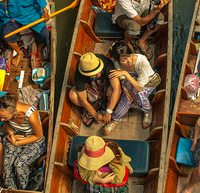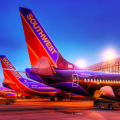The Best Travel Hacking Advice for People Who Can’t Get Credit Cards

I write about travel hacking a lot on the blog (and much more in the Cartel), and I always try to point people to the best available deals and opportunities. Some of these opportunities are for credit card signup bonuses, something I’ve been experimenting with for years, ever since first applying for 13 cards of my own on the same day way back in 2009.
Of course, not everyone is able or eligible to get these bonuses—so what else is out there? There’s actually a ton of different opportunities. Credit cards are an easy way to earn a big boost of miles and points in many different programs, but they certainly aren’t the only way.

First, Understand Why Card Products Are So Popular
In the past few years, bonuses have increased and card products have diversified. In some cases, the frequent flyer programs are more profitable than the airlines. American Express even started creating its own suite of lounges for its card members. This is big business!
If I’ve ever implied that you’re “taking advantage” of airlines, hotels, or banks by applying for card products (and carefully managing them, of course), I’ve overstated or exaggerated. They are happy to have you as a customer.
Nevertheless, these card products aren’t the only pathway to miles, points, and the whole world of “nearly free” travel in general. If you’re not able or eligible to apply for credit cards, or if you just prefer not to, you won’t be left behind in the terminal. (Well, you may have to wait until Zone 20 boards… just kidding!)

So, what can you do? Here are a few starting points.
Round-the-World tickets have nothing to do with credit cards.
Every year I travel on at least one Round-the-World ticket issued directly by a OneWorld or Star Alliance carrier. It’s still a good deal for a lot of people. You can price out a trip by using the free planning tools available from the alliances:
Earlier this year I began a 16-segment OneWorld ticket that took me through Doha, Paris, London, Los Angeles, Sydney, Hong Kong, and Tokyo—not counting a few other stopping points or transits. By the time I finish traveling on it, this ticket should earn more than 60,000 Elite Qualifying Miles, which gets me 60% of the way toward requalifying for Executive Platinum status (the highest available) on American Airlines.

Earning status—and then getting that status matched—has nothing to do with credit cards.
(Well, technically it has little to do with it.) These days, elite status matters more than ever.
At least several times a year, opportunities will arise to earn receive free status from a particular airline or hotel chain. This is often a good thing to sign up for, because even if you don’t plan to utilize the benefits from that offer, you can leverage it into status with an airline or hotel chain that you do care about.
Here’s some more background:
I mentioned that elite status with airlines and hotels has little to do with getting credit cards. There are a couple of exceptions that are worth noting, for those who are eligible. In some cases, merely getting the card includes the benefit of immediate status. Here are a few of the most common offers:
- Starwood Preferred Guest (Personal) – get two stays and five nights toward status every year you remain a cardmember
- Starwood Preferred Guest (Business) – get two stays and five nights toward status every year you remain a cardmember [and yes, you can get four stays + ten nights for having both cards]
- Hilton Honors Business Card – get free Gold status just for having the card
- The World of Hyatt Credit Card – get Platinum status just for having the card

Buying miles at a discount, and then using those miles to book amazing awards, can be done from anywhere.
Last year I purchased at least 150,000 miles. In previous years I’ve purchased many more. Why do I do that? Well, my goal is to buy low and redeem high. You do the math:
1. Buy miles for $1,500 each
2. Redeem them for plane tickets worth $4,000+ each
Not bad, right? And you can do this from anywhere in the world, no matter your age or credit score.
Note that you don’t usually want to purchase miles, since the price is often cost-prohibitive. Several times a year, though, the airlines will put them on sale, sometimes at 40% or 50% off, and then it gets a lot more interesting. (Keep up with current offers to buy miles at discounted rates in the Cartel.)

Speaking of redemptions, once you have the miles, there’s a whole different skill to learn—and once again, it has nothing to do with credit cards.
Learning how to use miles well is a field of work in itself. Mastering the art of redemptions is worth spending time on, and again, you don’t need a specific credit card to put your miles to good use.
To learn to redeem well, you’ll want to spend some time with airline and hotel award charts. With the exception of Delta, every airline or hotel chain publishes an award chart, where you can learn exactly how many miles or points you need for any particular trip.
Want to know how many miles it will take to get to Timbuktu? That’s easy: you need Flying Blue (Air France / KLM) miles, potentially transferred from American Express Membership Rewards, and 40,000 miles will get you there in Economy Class, or 60,000 miles in Business Class. Voila.

Many promotions are open to anyone, everywhere.
Long-time readers are probably familiar with some of my greatest hits from years past:
- Buying dollar coins from the U.S. mint at face value
- Buying $8,000 worth of useless stickers
- Getting a hair-loss consultation for 20,000 SkyMiles
… and a lot more.

Honestly, there are many, many more. I don’t write about all of them, mostly because this blog isn’t just about travel—but the point is, most promotions are open to all.
Mistake fares are also open to anyone, everywhere.
Several years ago I flew from Kuala Lumpur to Vancouver, Canada in Business Class for a bit more than $500. This fare would normally cost $3,000 or more, but the airline screwed up—and for a day or so, anyone could purchase at a big discount.
This is called a “mistake” or “glitch” fare, and when it happens, anyone can purchase. Sometimes the airline honors them and sometimes they don’t, but you’ll usually know one way or another within the first few days of purchase, after the fare gets a lot of attention.
Lastly, you should still be earning miles and points with U.S.-based programs even if you’re not in the U.S.
This point is often missed, but it’s important. The U.S. airlines aren’t always the best carriers (hello, Cathay Pacific, Singapore Airlines, and Emirates) but they do tend to have the best mileage programs. You can and should redeem your miles on other carriers, but in many cases you’ll be best served by concentrating your earning on the U.S. companies.
Remember: if you can’t get those big bonuses on U.S.-based credit cards, you aren’t left out. You can still see the world at budget prices. You can still have great experiences. Best of all, you can still travel.
###







